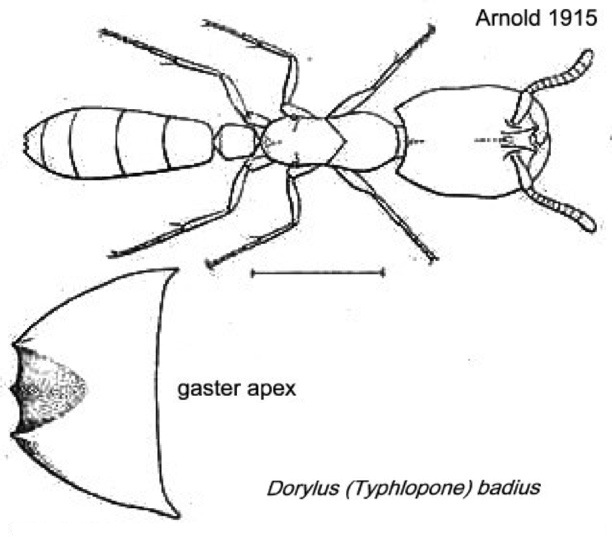Gerstäcker's (1859) description of badius is - "Dorylus
badius, n.sp.; pedunculo abdominis quadrato, mandibulis elongatis,
acutis, dilute rufo-brunneus, cano-tomentosus, abdomine
sericeo-micante, segmento ultimo laevi, apice rufo-piloso; capite
negro, vertice alto elevato, alarum venis nigro-fuscis. Long. lin.
14-15½. Mas.". 
Santschi's (1914b) description of the badius
workers is at  . .
|
 Arnold (1915) gave the following notes and descriptions
- Arnold (1915) gave the following notes and descriptions
-
"The type species appears to be confined to the northern portion, of
Africa, and is replaced in equatorial and S.E. tropical Africa by the
following race, which has not been recorded to my knowledge from
temperate South Africa.
The sub-genus includes only this species and D. labiatus of the
Indian region.
Description - race badius Gerstaecker. (Plate IV., figs, 31,
31a, 32, 32a, 32b.)
Major worker. TL 13 mm, head 3.2 mm long X 2.8 mm wide.Mandibles
piceous brown, scape of antenna, head and thorax dark castaneous red,
but getting gradually lighter from the head to the petiole; abdomen
dark brownish yellow, or ochreous with a slight reddish tinged; legs
ferruginous; funiculus dark brown above, lighter underneath. Head,
thorax and abdomen very shining, except the anterior third of the head,
the vertical anterior face of the pronotum, the mesopleura, the petiole
and the propodeum, which are duller, owing to a rugulosity of the
surface which is almost microscopic on the head, but somewhat stronger
on the other parts. Head sparsely punctured, with small, discrete and
shallow punctures; scape of antenna more coarsely punctured. Pro- and
mesonotum sparsely, but much more coarsely punctured than the head.
Propodeum and petiole very shallowly and more closely punctured, the
punctures being smaller than on the pronotum. Gaster finely and
sparsely punctured. A short, yellow pubescent hair is inserted in each
puncture, those on the head being very fine.
Head very slightly narrowed posteriorly, the sides are almost parallel,
posterior margin shallowly arcuate. Mandibles sub-nitidulous,
striato-punctate, the apex sub-acute, the pre-apical tooth small and
blunt, the sub-apical very obtuse or represented only by a swelling on
the margin. The frontal carinae are considerably raised, divergent and
vertical, in front, and project distinctly over the very short clypeus;
they are angularly bent just above the antennal sockets, so that their
posterior half is horizontal. Between them posteriorly is a very smooth
and shining oval area, which is continued into a, moderately deep
groove with rounded margins which becomes very faint on the vertex, and
again deepens towards the occipital margin. The frontal carinae are not
spinously produced backwards as in helvolus and affinis.
Antennae 11-jointed; the scape is strongly incrassate towards the apex,
and not longer than the first 7 joints of the funiculus. The 1st joint
of the funiculus very short and about as long as wide, all the other
joints except the apical much wider than long; all the joints closely
punctured and densely pubescent beneath.
Pronotum narrowed and depressed anteriorly to form a short neck; it is
widest behind this part and. narrows towards the mesonotum, from which
it is separated by a distinct and angular suture. The mesonotum widens
posteriorly, where it is two-thirds wider than long. The propodeum is
widest at its base (on each side of which lies a prominent spiracle),
and narrows but slightly towards the short and vertical declivity; the
brow of the latter is considerably rounded above and at the corners.
The dorsum of the propodeum has a longitudinal median impression. Seen
from the side, the dorsum of the whole thorax is flat and rather
distinctly delimited from the sides, which are vertical or nearly so.
The node of the petiole is almost sub-quadrate, or a little wider
behind than in front, as long as, or only very little longer than wide,
all the angles strongly rounded; the ventral lamella is produced into a
triangular projection.
The gaster widens gradually towards the apical margin of the 3rd
segment, all the segments wider than long. The pygidial area of the 5th
segment is dull and only shallowly impressed, forming a more or less
oval fovea, not semi-circular or bounded by a sharp raised margin, as
in the subgenus Dorylus. By this character, and also by the
longer petiole and the frontal carinae without spines, all the workers
of this species can be distinguished at a glance from those of the
subgenus Dorylus.
Worker minor - TL 8-3 mm. In these the colour is much lighter, or more
or less reddish yellow. Antennae 11-jointed, as in the maxima.
Proportionately the head is wider in front than in the maxima. The
puncturation is finer and the pubescence is more apparent. In the
smaller forms, the frontal carinae project further forwards and are
more convergent posteriorly, or even meet to form a single lamina. The
median impression on the head is much shallower and shorter, or almost
obsolete. The mandibles are more shining, with three teeth more acute
and distinctly defined.
Worker minima. It is probable that there are some of this class, and
measuring less than the smallest of the minor class. I do not, however
possess any smaller than 3 mm, nor do I know of any workers of of a
smaller size of this race having been described by any author.
The males of this species are exceedingly common at light during the
rainy season in Zimbabwe (South Rhodesia); the workers however, do not
appear to be so frequently met with as helvolus. Females
unknown.
(G.A., R.M., S.A.M. colls.)"
Arnold's (1915: 126 ff) descriptions are at  and male and male  . .
|
![]() Dorylus
fulvus base page; Key to workers
Dorylus
fulvus base page; Key to workers ![]() ;
Key to males
;
Key to males ![]()